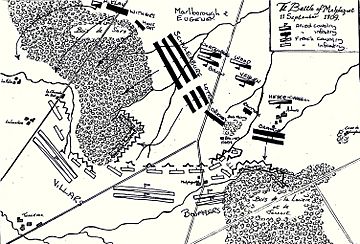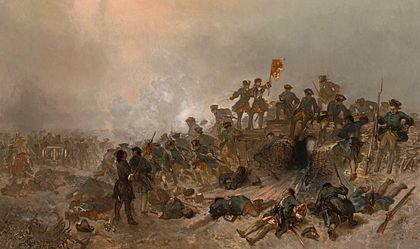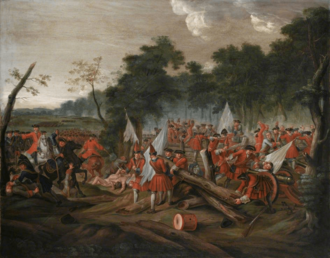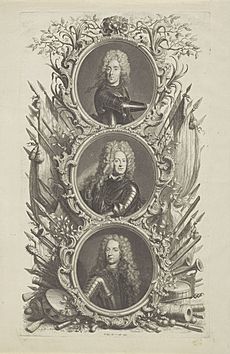Battle of Malplaquet facts for kids
Quick facts for kids Battle of Malplaquet |
|||||||
|---|---|---|---|---|---|---|---|
| Part of the War of the Spanish Succession | |||||||
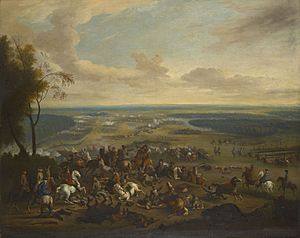 The Battle of Malplaquet, Jan van Huchtenburgh |
|||||||
|
|||||||
| Belligerents | |||||||
| Commanders and leaders | |||||||
|
|||||||
| Strength | |||||||
| 86,000 men, 100 guns | 75,000 men, 80 guns | ||||||
| Casualties and losses | |||||||
| c. 22,000 | c. 11,000 | ||||||
The Battle of Malplaquet took place on 11 September 1709 during the War of the Spanish Succession, near Taisnières-sur-Hon in modern France, then part of the Spanish Netherlands. A French army of around 75,000 men, commanded by the Duke of Villars, engaged a Grand Alliance force of 86,000 under the Duke of Marlborough. In one of the bloodiest battles of the 18th century, the Allies won a narrow victory, but suffered heavy casualties.
Allied advances in 1708 led to the renewal of peace talks, which collapsed in April 1709. After taking Tournai in early September, the Allies besieged Mons, whose capture would allow them to enter France itself, and Louis XIV ordered Villars to prevent its loss. Although the two armies made contact on 10 September, the attack was delayed until the next day, giving Villars time to construct strong defensive positions.
After an opening artillery barrage, the Allied infantry made simultaneous assaults on the French flanks. These were intended to divert troops from their centre, weakening it sufficiently so it could then be broken by a mass Allied cavalry charge. Although successful in previous battles, at Malplaquet the flank attacks incurred heavy casualties, while the French cavalry ensured their centre did not collapse. This allowed their infantry to retreat in good order, with the Allies too exhausted to conduct a pursuit.
Most historians estimate Allied losses as approximatively 22,000 killed or wounded, those of the French being around 11,000. These levels shocked contemporaries, and heightened internal divisions within the Grand Alliance over the wisdom of continuing the war. By saving his army, Villars ultimately enabled Louis to negotiate far better peace terms in 1713 than those available in 1709. However, it did little to change the immediate strategic situation; Mons surrendered shortly afterward and the Allies resumed their advance in 1710.
Contents
Background
By early 1709, the French state was bankrupt, while the severe winter of 1708–1709 caused widespread famine; garrisons at Tournai, Arras, St Omer, Valenciennes and Cambrai all mutinied over lack of food and pay. Desperate to end the war, Louis XIV initiated peace talks with the Grand Alliance in The Hague. He accepted most of their terms, including replacing his grandson Philip V of Spain with the Habsburg candidate Archduke Charles, the ostensible principle for which they were fighting. However, he and his ministers could not agree to the demand he provide French troops to do so, and talks broke down at the end of April.
When the 1709 campaign began, Louis ordered Villars to avoid battle and prevent any further deterioration in the French position. Ordinarily an extremely aggressive general, Villars instead built defensive lines along the River Scarpe, running from Saint-Venant to Douai.
For their part, the Allies were convinced France was on the verge of collapse, and looked to keep up the pressure by advancing through the line of border fortresses known as the Frontière de fer. However, while Louis XIV ultimately determined French strategy himself, Allied plans had to be approved separately by the British, Dutch and Austrian governments, which often required compromise. Marlborough, the Allied commander, considered the positions held by Villars too strong for a frontal assault, and since the Dutch opposed his preferred option of Ypres, he agreed to make Tournai the main objective for 1709.
Although persistent heavy rain caused further delays, the siege of Tournai commenced on 15 June; one of the strongest fortresses in France and held by a garrison of 7,700, it surrendered on 3 September and Marlborough immediately marched on Mons. Having assumed Tournai would hold out until October and thus consume the entire 1709 campaign season, Louis now ordered Villars to prevent the loss of Mons "at all costs...the salvation of France is at stake". The main Allied army arrived east of the town on 7 September, awaiting the arrival of their siege artillery from Tournai; Villars took up positions to the southwest on 9th, leaving the two forces facing each other across the gap of Malplaquet.
Battle
Knowing Villars had been instructed to fight for Mons, Marlborough and his deputy Prince Eugene of Savoy were confident of winning a victory that would effectively end the war. On the other hand, while conscious of the implications of defeat, Villars had previously informed Louis XIV he must fight, or his army would dissolve. The Allies delayed their attack pending the arrival of 1,900 men from Tournai under Henry Withers, a decision criticised then and later, one analyst arguing "the battle should have taken place on the 10th (September) or not at all". This gave Villars an extra day to construct defensive positions, including earthworks covering the open ground in the centre, and additional entrenchments extending into the woods on either side.
Marlborough's plan was that successfully employed at the earlier battles of Blenheim, Ramillies and Oudenarde. On each occasion, frontal assaults on the French flanks forced them to move troops from the centre, which was then broken by mass cavalry attacks. Although the leading units took heavy casualties, overall losses were substantially less than those suffered by the defeated. In contrast, at Malplaquet the French held strong defensive positions, were better led, and highly motivated. Villars had also learned from defeat at Ramillies, where he arguably over extended his line. At Malplaquet, the battlefield was much more restricted, allowing him to concentrate his infantry in defensive positions. It also prevented Marlborough from quickly shifting troops between wings, an approach he often adopted to keep opponents off balance.
The French army consisted of 80 guns and between 75,000 to 80,000 men, including significant numbers of Bavarian and Swiss mercenaries, as well as the Irish Brigade. Villars himself commanded the left, de la Colonie the centre, with the right led by 67-year-old Marshal Louis-François de Boufflers, who was senior to Villars in rank but volunteered to serve under him. The infantry held a continuous line of entrenchments supported by artillery, with the cavalry massed in the rear. The Allies had roughly 86,000 men and 100 guns, with around 30,000 German and Danish infantry under Prince Eugene on the right. The left wing contained 18,000 Dutch infantry led by the Prince of Orange, under the overall control of Count Tilly, who had succeeded Lord Overkirk as senior Dutch commander. Finally, the experienced Earl of Orkney commanded the centre, consisting of 8,000 mostly British infantry, with the bulk of the 30,000 cavalry to their rear.
The battle began at 07:00 on 11 September with an artillery bombardment. This ended at 08:30, when the Allied right assaulted French positions in Sars Wood, led by Count Finckenstein, Lottum and Schulenburg. Three hours of close combat ensued, with both sides taking heavy losses, while Prince Eugene was wounded in the neck, but refused to leave the field. At around 09:00, the Dutch, commanded by François Nicolas Fagel, moved against the French right with 13 battalions, including Swiss mercenaries and the Scots Brigade. Despite some initial success, they were repulsed, and the Prince of Orange and Sicco van Goslinga then ordered another 17 battalions to support Fagel by attacking French positions around Blairon Farm.
The Dutch managed to capture Blairon Farm, but incurred over 5,000 casualties in doing so, including many senior officers. They persisted with incredible fortitude until Marlborough told the Prince of Orange to stop, and the Dutch infantry withdrew to their original positions, covered by the German cavalry. Orkney later wrote the Dutch dead lay "as thick as ever you saw a flock of sheep." Some British commentators claim the attack was supposed to be a "demonstration" rather than a full scale assault, but this appears unlikely. Marlborough blamed himself for not monitoring these assaults more carefully, and took full responsibility for the failure.
Meanwhile, the attacks by Prince Eugene had forced Villars to move troops from the centre to prevent the collapse of his left wing. Withers and the detachment from Tournai arrived too late to support the Dutch, and were instructed instead to make a flanking move north of the French lines in Sars Wood. This manoeuvre took over two hours to complete, by which time the fighting had largely ended, but their approach forced Villars to reinforce his left with another twelve battalions. By midday, he had taken over seventy-seven battalions from the centre, leaving nine French battalions and sixty cavalry squadrons facing twenty-three and eighty respectively. This allowed Orkney to over-run their positions in the early afternoon; soon after, Villars was badly wounded and transferred command to Boufflers, with Puységur taking over the left.
The Allied cavalry now moved past the captured earthworks in the centre and formed up on the other side, where they were attacked by the elite Maison du Roi cavalry under Boufflers. Orkney was driven back, before the French in turn were repulsed by the Allied infantry, while the French left finally began to crumble under pressure from Withers and Schulenburg. The Prince of Orange ordered another mass assault on the French right, and a few Dutch cavalry squadrons under Frederik Sirtema van Grovestins broke through their positions. Followed by the rest of the Allied horse, they engaged the French in what was the largest cavalry action of the 18th century. Puységur began to withdraw, and at 15:00 Boufflers ordered a general retreat in the direction of Le Quesnoy, some 25 kilometres (16 mi) away, with the Allies too exhausted to pursue.
Casualties
Most historians calculate Allied casualties as around 21,000 to 25,000 killed or wounded, 8,462 of which were incurred by the Dutch infantry, although Hans Delbrück claimed they exceeded 30,000. There is less consensus on French losses, the most common estimates being between 11,000 to 14,000. Others suggest a low of 7,000 to a high of 17,000 killed or wounded, plus 500 prisoners.
Aftermath

Although horrified by the casualties, contemporaries considered Malplaquet an Allied victory since they retained possession of the battlefield, while Mons surrendered on 21 October. The French commanders focused on the losses they inflicted, Boufflers reporting to Louis XIV that "...misfortune compels me to announce the loss of another battle, but I can assure your Majesty misfortune has never been accompanied by greater glory". In a similar vein, Villars later wrote: "If God grants us the grace to lose such a battle again, Your Majesty can count on all of his enemies being destroyed".
It has also been argued Malplaquet was a French strategic victory; despite the loss of Mons, keeping his army largely intact meant Louis was able to negotiate far better peace terms in 1713 than those available in 1709. However, while it highlighted Allied divisions over war aims and concerns over the cost, these issues predated Malplaquet; even before the 1709 campaign, Marlborough was among those who felt Whig demands of "No Peace Without Spain" were excessive. In that respect, Malplaquet had less impact on British government policy than Spanish successes at Alicante and La Gudina.
At the beginning of the war, the French army was viewed as the best in Europe, a reputation shattered by a series of defeats between 1704 and 1708. French historian André Corvisier suggests the importance of Malplaquet in French military history was primarily psychological; despite being a narrow defeat which did little to change the immediate strategic situation, it is seen as more significant than their victory at Denain in 1712. He argues 18th century authors viewed it as the point when the French army regained its confidence, while for those writing after the 1870 Franco-Prussian War, it provided proof of French resilience and ability to recover from catastrophic defeat.
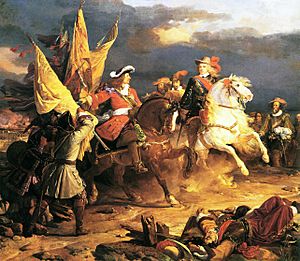
Prior to the resumption of peace talks in 1710, Marlborough wrote to the Allied negotiators that 'thanks to our victory..., you may have what peace you want'. His reasoning was the French failed to hold Mons, and after Malplaquet could only act on the defensive. In spring 1710, the Allies resumed their advance almost unopposed; by September they had broken through the secondary line of the "Pré carré", capturing Douai, Béthune, Aire and Saint-Venant. Short of supplies due to crop failures, and with many regiments reduced to less than half their official size, Villars could not risk the last significant French field army in another battle.
The immediate impact of Malplaquet was political rather than military and when peace negotiations resumed in March 1710 at Geertruidenberg, it was clear the mood in Britain had changed. Although actual British losses were comparatively low, his domestic opponents used the heavy casualties to attack Marlborough. Reluctance to continue fighting for what seemed marginal gains resulted in a landslide victory for the Tories in the October 1710 British general election, although they confirmed their commitment to the war to prevent a credit crisis. Despite success in France, British opposition to continuing the war was strengthened by defeats at Brihuega and Villaviciosa in December 1710 which confirmed Philip V as king of Spain, the ostensible cause of the war in the first place.
The Dutch blamed their losses on Marlborough's tactics, as well as Withers for allegedly failing to support them. The Prince of Orange was also criticised for continuing his attacks when it became clear the French positions were too strong. Nevertheless, he was entrusted with concluding the siege of Mons, which surrendered at the end of October. However, unlike the English, Grand Pensionary Anthonie Heinsius and other Dutch politicians felt their heavy casualties required more stringent peace terms. Sicco van Goslinga, one of the Dutch field deputies attached to Marlborough's staff, considered their demands unrealistic. He argued such casualties were to be expected, given they had taken Lille and Mons, "two of the strongest fortresses in Europe", and won "one of the hardest battles ever fought".
In April 1711, the Habsburg candidate for the Spanish throne, Archduke Charles, succeeded his brother Joseph as Holy Roman Emperor, making the continuation of the war pointless since the union of Spain with Austria was as unwelcome to Britain as one with France. While the capture of Bouchain in September 1711 left the road to Paris open, the British bypassed their allies and secretly negotiated peace terms directly with Louis XIV, signing the Preliminary Articles of London on 8 October 1711. At the end of 1711, Marlborough was replaced by the Tory Duke of Ormonde, who was ordered to prevent any further offensive action by British troops.
Swiss mercenaries fought on both sides in the battle, six battalions with the French, including two of Swiss Guards, and another eight with the Dutch. Two were commanded by members of the von May family from Bern, Gabriel for the Dutch and Hans Rudolf for the French. With more than 8,000 Swiss casualties, the battle caused heavy controversy in the Swiss Diet. Malplaquet was the last action where Swiss mercenaries directly engaged one another until Bailén in 1808.
Written many years later, a firsthand account of the battle is given in the book Amiable Renegade: The Memoirs of Peter Drake (1671–1753). An Irishman who served in various European armies, Drake fought with the Maison du Roi at Malplaquet and was captured after being wounded several times. Another notable Irish émigré, Féilim Ó Néill, was among those killed serving with the Irish Brigade.


